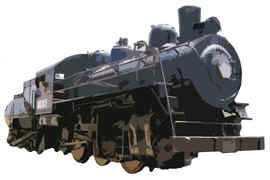

Electrical
![]()
![]() Great things can be done with LEDs – lighted buildings, sequential runway lamps, flashing lighthouse and airport beacons, lighted subways, pulsing buoy markers – but safety must come first.
Great things can be done with LEDs – lighted buildings, sequential runway lamps, flashing lighthouse and airport beacons, lighted subways, pulsing buoy markers – but safety must come first.
![]() A first thought was to run 12 Volt DC jumpers underneath and between tables. In practice, this would be troublesome and potentially unsafe. Jumpers could be 'hidden' by running them through the segment ends, where they would be inaccessible when modules are bolted together. This would be practical in a permanent table display or shelf railway, but a safer, simpler alternative is to power segments individually using 9 Volt batteries. Then, any 'powered' segments are truly compartmentalized. A transformer and electrical connection to an outlet might be fine for a shelf arrangement, but is sure to be a problem in the middle of a room full of kids... A small lockable panel below the module could hold the 9 Volt battery to ensure there is no contact with electrical connections. Include a switch or timer to turn lights on and off.
A first thought was to run 12 Volt DC jumpers underneath and between tables. In practice, this would be troublesome and potentially unsafe. Jumpers could be 'hidden' by running them through the segment ends, where they would be inaccessible when modules are bolted together. This would be practical in a permanent table display or shelf railway, but a safer, simpler alternative is to power segments individually using 9 Volt batteries. Then, any 'powered' segments are truly compartmentalized. A transformer and electrical connection to an outlet might be fine for a shelf arrangement, but is sure to be a problem in the middle of a room full of kids... A small lockable panel below the module could hold the 9 Volt battery to ensure there is no contact with electrical connections. Include a switch or timer to turn lights on and off.
![]() Obviously lights should be positioned in a protected place too. Consider recessing or placing LEDs behind clear panels so they cannot be chewed, pulled, or crushed. It is tempting to run 12 Volt DC jumpers between tables from underneath but that could be troublesome or unsafe. Jumpers could be ‘hidden’ by running these through the butted segment ends where they would not be accessible when the modules were clamped up, although this probably only makes sense for a permanent display.
Obviously lights should be positioned in a protected place too. Consider recessing or placing LEDs behind clear panels so they cannot be chewed, pulled, or crushed. It is tempting to run 12 Volt DC jumpers between tables from underneath but that could be troublesome or unsafe. Jumpers could be ‘hidden’ by running these through the butted segment ends where they would not be accessible when the modules were clamped up, although this probably only makes sense for a permanent display.

Adjustable Interval Timer Kit
Adjustable LED Flasher Kit
LED Chaser Kit
LED Flashing Kit
|
|

Runway Lighting Kit
Airport Beacon Kit
Tower Beacon / Flasher
Chasing LED Kit - White for Airports
Lighthouse Flasher
Flashing Buoy Beacon Kit
Campfire Kit
Blacksmith Forge Fire
Super Welder Kit
Building on Fire Kit
Alternating Flasher
Traffic Light Kit
LED Illuminator Kit
|